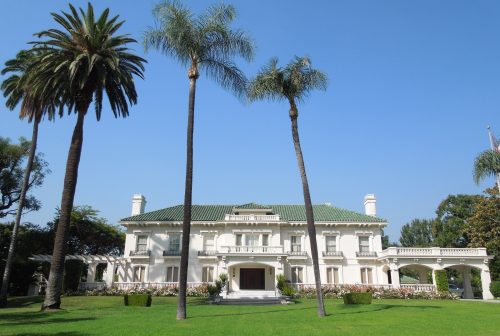The Wrigleys’ first California residence was in Pasadena.
By Megan McKinney
If William Wrigley Jr.’s early story was a classic inspiration to newsboys all over America, the man lived elements of the legend throughout his life. He was ruddy, clear-eyed and genial—a flamboyant, backslapping man who always carried packages of gum with him, which he solemnly distributed to those he met. Until his death at 70, he was without gray in his hair and looked 20 years younger than he was.
His was a routine of early to bed, early to rise and regular exercise, including the horseback riding he engaged in throughout most of his adult life.
The Wrigley Westward move was incremental, beginning—as it has traditionally been for so many Chicago families—with the need to escape the area’s bitter winters. For William and Ada, the first phase was to spend a portion of the winter in Pasadena, California, where in 1906 they acquired an Italian Renaissance-style mansion. The house would remain in the Wrigley family until Ada’s 1958 death, and its subsequent presentation to the City of Pasadena, with the understanding it would become the permanent headquarters for the Tournament of Roses.
 Tournament House in Pasadena.
Tournament House in Pasadena.
Pasadena was merely the beginning. Native Philadelphian William had long been a core Chicagoan; however, he was genuinely enthralled by the Southwestern United States.
The Wrigley Western entrenchment became even firmer when William bought controlling interest in the Santa Catalina Island Company in 1919. He improved Catalina with public utilities, a hotel, new steamships and a casino. He oversaw extensive planting of trees, shrubs and flowers, further enhancing the island. And he developed a business to employ local residents, using clay and minerals found on the beach to produce tile and pottery products. Most of all, he turned Santa Catalina Island, 20 miles off the California coast, into something of a resort, and—in doing so—created a combination family vacation spot, commercial venture and site of the Chicago Cubs spring training camp from the 1920s to 1950s.
In the early 1970s, the next generation, Philip K. Wrigley, Philip’s wife, Helen, and his sister, Dorothy Offield, would establish the Catalina Island Conservancy, to which they transferred all family ownership to preserve and protect the island, including 42,135 acres of wildlands, ensuring protection of the land and its wildlife.
The Wrigley Mansion on Catalina Island.
In 1921, William built the 9,800-square-foot Colonial-style main house and 2,800-square-foot servants’ wing on top of Mt. Ada, a tribute to his beloved wife. Wrigley watched his Cubs in spring training in the canyon from his den at the front of the great house.
The island’s name will continue to resonate in Chicago next year with the 2018 opening of the Catalina Club, one of four high-end facilities currently being developed for well-heeled fans at Wrigley Field; the luxe Catalina will be on the upper level behind home plate.
The sprawling Phoenix mansion.
If Wrigley was enthralled by the West in general, he was mesmerized by the Arizona desert. He bought the Arizona Biltmore in Phoenix, a trophy hotel whose construction had been supervised by consulting architect Frank Lloyd Wright. Although continuing his telephone meetings with the Chicago office for an hour or so every day, William was spending a great deal of time at his Phoenix house adjacent to the hotel. When in Chicago, he invariably lunched at the Wrigley Building Restaurant. Why not? It was his club, and in those days, everybody was there.
In addition to engaging in various Chicago enterprises with such friends as Albert Lasker and John Hertz, he was continuing to expand his gum empire—into Canada in 1910; Australia, in 1915; and England, in 1927.
An enthusiastically anticipated event of 1924 in Wrigley’s Midwestern base was the opening of the Chicago Riding Club. For this project, the cozy core of wealthy Chicago entrepreneurs—consisting of Wrigley, Lasker, Hertz and a few others, who had invested together over the years—expanded to a group of l7, headed by Chicago Tribune editor and publisher Colonel Robert R. McCormick. This enlarged investment group purchased a massive site at McClurg Court, on which the club, designed by fashionable Gold Coast architects Rebori, Wentworth & Dewey, would be built.

The Chicago Riding Club under construction in Streeterville in 1924.
Other members of the board of directors included McCormick’s cousin Joseph Medill Patterson, Samuel Insull, Joseph T. Ryerson, Harold Foreman and John Borden. Until then, Chicago had been the only large American city without a prestigious club centered on equestrian activity, and for a dozen years, the Riding Club was an esteemed location for members to ride horses, view horse shows and play polo.

CBS Television Studios.
If the project is beginning to look and sound familiar, today’s Chicagoans may remember it as the site of the CBS Television Studios from 1954 until 2008. If, for no other reason, it will remain in history as the site of the election-tipping first Kennedy-Nixon debate, an event which even today is discussed frequently in the popular media.
Megan McKinney’s series The Wrigleys of Wrigley City is scheduled to continue with “Inventing Michigan Avenue” on Sunday, October 15.
Author Photo:
Robert F. Carl














